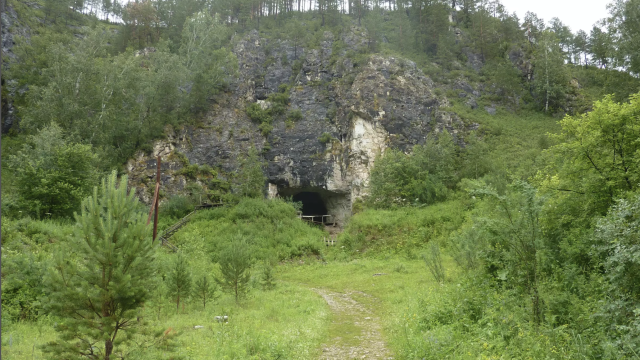The Denisovans, a mysterious group of extinct hominins closely related to Neanderthals, didn’t leave much fossil evidence behind. A fresh dig at their former stomping grounds in Siberia has now yielded three new fossils — the oldest yet found of this species.
Katerina Douka, an evolutionary anthropologist from the University of Vienna, and her colleagues found the fossils in Denisova Cave, a natural shelter located in the Altai Mountains of southern Siberia. The scientists were studying the oldest layers in the cave, which up until now had failed to produce a single human fossil. A total of five human fossil fragments were recovered: three belonging to Denisovans, one from a Neanderthal, and one that could not be identified. The largest of these fragments measures no larger than 4 centimetres long.
Remarkably, this small but precious handful of fossils were found amid a jumble of 3,791 animal bone fragments. The researchers used a biomolecular method known as peptide fingerprinting to identify the bones, as it was not possible to do so through manual inspection. The five bones contained collagen consistent with the peptide profiles of humans (peptides are the building blocks of proteins), allowing for the identification (as a reminder, Denisovans and Neanderthals are humans).

“Finding one new human bone would have been cool, but five? This exceeded my wildest dreams,” Samantha Brown, a co-author of the study and junior group leader at the University of Tübingen, said in a Mac Planck Institute statement.
Denisova Cave is an “amazing place” when it comes to the preservation of DNA, and “we have now reconstructed genomes from some of the oldest and best-preserved human fossils,” said Diyendo Massilani, a geneticist from the Max Planck Institute of Evolutionary Anthropology, in the release. The team found enough DNA to reconstruct mitochondrial genomes, allowing them to confirm the bones as belonging to Denisovans and Neanderthals. A paper detailing this discovery has been published in Nature Ecology & Evolution.
The layer containing the Denisovan bones was dated to roughly 200,000 years old. Previous Denisovan fossils were dated to between 122,000 and 194,000 years old, so these are now the oldest. The lone Neanderthal bone was dated to between 130,000 and 150,000 years ago. The Altai mountains appear to “be an overlapping zone for both Denisovan and Neanderthal groups for over 150,000 years, witnessing and possibly facilitating population [interbreeding] as well as sustaining distinct hominin populations over this long period,” according to the paper.
The three new Denisovan fossils add to the six already discovered, including a finger bone from which DNA was extracted and a mandible found in a cave on the Tibetan Plateau — the first and only Denisovan fossil found outside of Siberia. Denisovans were closely related to Neanderthals, and they interbred with modern humans prior to going extinct some 50,000 to 30,000 years ago. Traces of Denisovan DNA exist within the genomes of modern southeast Asian and Oceanian populations.
As the scientists write in their study, “a wealth of archaeological material” in the form of stone tools and animal remains were found within the Denisovan layer. It’s the first time that archaeological evidence has been definitively linked to these hominins, allowing for new insights into their behaviour.
Interestingly, the style of the recovered stone tools, like scraping tools for working animal hides, could not be matched to any known lithic tradition. Living near the Anui river and occupying the caves during a warm period, the Denisovans hunted bison, deer, gazelle, antelope, and woolly rhinos, in a subsistence pattern that lasted for thousands of years, as the researchers point out.
These three Denisovan bones will likely produce more science in the years to come, as will Denisova Cave in general. Slowly but very methodically, we’re uncovering more about these remarkable humans.
